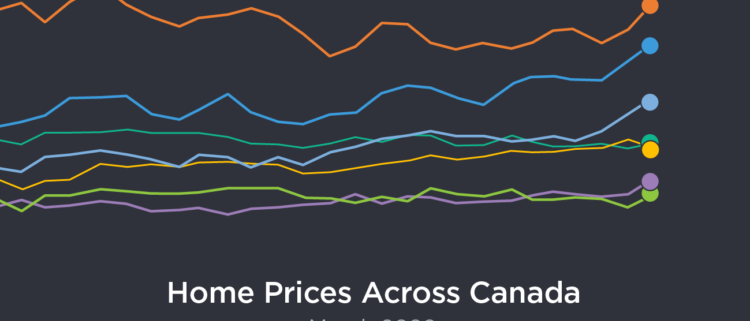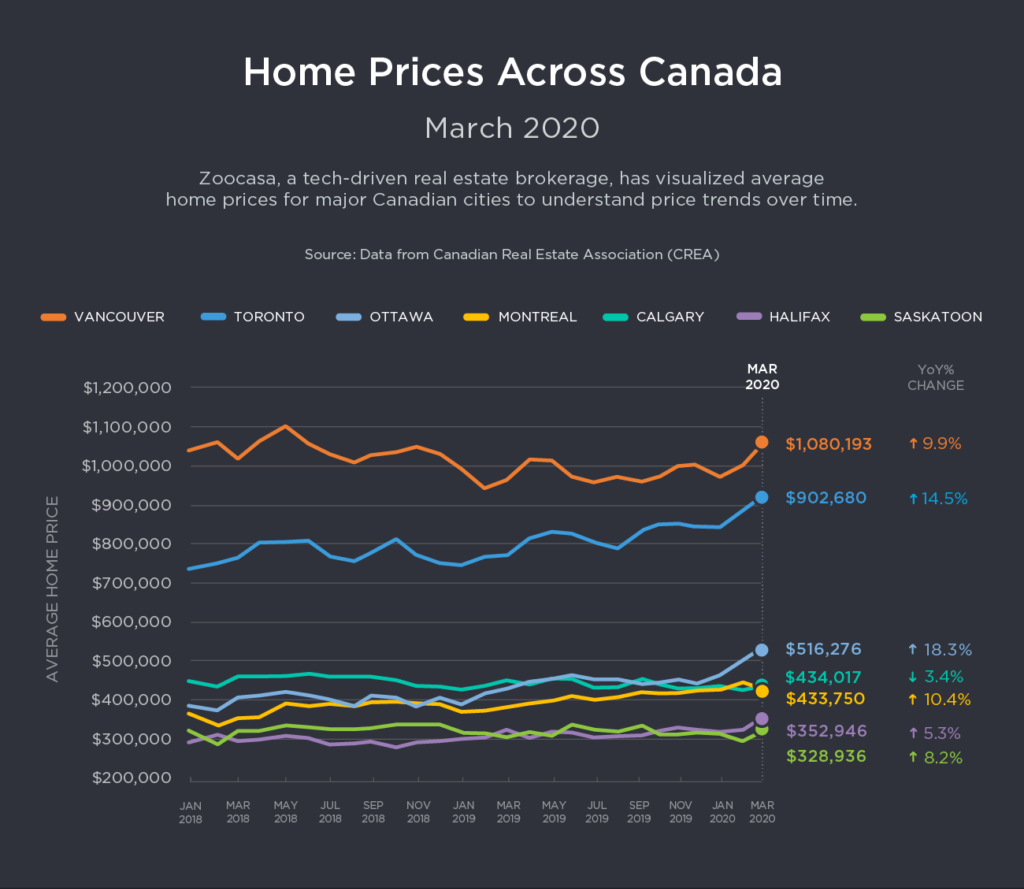National sales and new listings were stifled in March, as home buyers and sellers across the country remained on the sidelines in the second half of the month in reaction to healthcare and economic measures to combat COVID-19.
Although sales crept up 7.8 per cent year-over-year (y-o-y), there was a stark decline in sales compared to February of this year, when the market was gearing up for a busy spring season. Compared to last month, home sales fell 14.3 per cent nationally, with declines experienced across major markets across the country. The Greater Toronto Area (GTA) saw the largest month-over-month (m-o-m) decline of 20.3 per cent, followed by Montreal (-13.3 per cent) and the Greater Vancouver Area (-2.9 per cent).
National home prices grew 12.5 per cent to $541,926. Excluding the GTA and Greater Vancouver, this figure drops nearly $130,000. The Home Price Index, which reflects the value of homes sold grew slightly m-o-m by 0.8 per cent, and 6.9 per cent y-o-y.
COVID-19 Impact Reflected in Second Half of March
While there was an overall increase in y-o-y sales, CREA’s senior economist, Shaun Cathcart noted that “numbers for March 2020 are a reflection of two very different realities, with most of the stronger sales and price growth recorded during the pre-COVID-19 reality which we are no longer in.” CREA notes that data for the second half of March considered in tandem with preliminary figures for April paint a different, more realistic picture of the current state of the market as illustrated by early April numbers trending at about “half of what would be normal for that time of year.” As such, although we can begin to see some shifts, the full impact of COVID-19 on Canada’s housing market will be more apparent in the coming weeks.
As more buyers and sellers reconsidered entering the market over the course of March, new listings reflected a similar downward trend to sales, with a 12.5 per cent drop since February 2020. As such, the 12-month moving average sales-to-new-listings ratio (SNLR), which is a measure of buyer competition, inched back to 62.1 per cent from 54.6 per cent last year. For reference, a range between 40 – 60 per cent indicates balanced conditions, while below and above that threshold indicate local housing market conditions favouring buyers and sellers, respectively.
Given the magnitude and impact of COVID-19 response measures across the country, Canada’s national housing market remains relatively stable in the immediate term, with CREA stating that “this measure of market balance was remarkably little changed“ compared to February. They report that two thirds of markets remained in balanced territory over March, with the remainder exhibiting sellers’ market conditions.
Months of inventory – a measure of the time it would take to liquidate available market supply at the current rate of sales activity – is sitting at 4.3 months nationally, which is half a per cent higher than February, but still nearly a full percentage point lower than the long term average of 5.2 months. As noted earlier, this can be attributed to the steep drop in sales and new listing activity in the latter half of March.
Home Prices Continue to Trend Over Regional Lines
The ongoing regional trend in home price activity continues across the country, with Ontario experiencing a 14.7 per cent annual increase in average home prices to $682,779 and British Columbia also experiencing an uptick in average price growth of 14.9 per cent y-o-y to $788,425.
The average price in the GTA rose 14.5 per cent y-o-y to $902,680 although the rate of growth was slower compared when compared to February, when average prices grew 16.6 per cent y-o-y. Further East, Ottawa average home prices continued on an upward trajectory last month, rising 18,3 per cent annually to $516,276. Montreal followed suit, with a 10.4 per cent annual increase in average prices to $433,750.
In Western Canada, Vancouver average home prices sit at $1,080,193, up nearly 10 per cent y-o-y. In the Prairies, both Edmonton and Calgary experienced annual average price declines at 4.7 per cent and 3.4 per cent respectively.
Learn more about how home prices performed in markets across Canada in March in our infographic below:









 Maziar Moini, Broker of Record - Home Leader Realty Inc.
300 Richmond St. W., #300, Toronto, ON M5V-1X2
Maziar Moini, Broker of Record - Home Leader Realty Inc.
300 Richmond St. W., #300, Toronto, ON M5V-1X2



